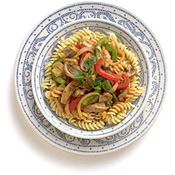|
|
Cuisine Glossary
| You have reached our International Cuisines and information on all aspects of a countries cuisine.
We will try to explain the culture, significant influences, climate, and other factors that have come together to create a distinct style. For example: Spanish, Mexican or Japanese. |
Nepalese Cuisine
 |
The Nepali cuisine, also known as cuisine of the Himalayas, bears uniqueness in that it merges two great culinary traditions of the region, namely Indian and Tibetan, into a mainstream culinary culture of its own, reflecting the geographic as well as demographic diversity that exists in the Himalayas. Nepal, a tiny country by any geometric measurements, stretches from the lowlands of the sub-tropical terrain plains in the South to the highlands of the Himalayas, the tallest in the entire world as reigned by Mt. Everest, in the North. Hence, Nepal has resurrected its own unique cultural identity into a homogeneous and monolithic culture, combining different traditions of different indigenous cultures that have roots in all corners of the country.
The Nepali staple consists primarily of rice, wheat, corn, lentils coupled with fresh vegetables and meats. A typical Nepali meal can be characterized by Dal (lintels soup), Bhat (steamed rice) and Tarkari (vegetable preparation), also known as The Trinity, supplemented by some meat preparation. Typical Himalayan dishes include Dals(lentils) Tarkaris (curried vegetables or meat), Bhutuwas (stirfried meat or vegetables), Sekuwas (grilled meat or vegetables), Chewayalas (grilled meat marinated in seasoned musturd oil), rotis (bread preparations), MOMO (stuffed dumplings), Thukpas and Chow-Chows (Himalayan stewed and stirfried noodles), Sukutis (crispy and spicy meat slices), Quantees (meat or vegetable stews with sprouted beans), Achars (chutney preparations), Chai (seasoned or unseasoned tea), and many others. Many Nepali dishes are inspired by the great culinary tradition of the indigenous Newari culture that exists predominantly in the Kathmandu Valley. Source: HungryMonster Writers |




